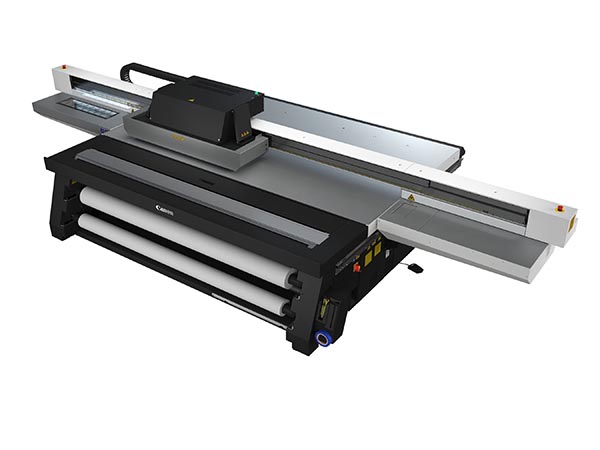Canon Solutions America Launches Fifth-Generation Arizona Series UV Flatbed Printer
Yesterday, Canon Solutions America (CSA) launched the latest in its Arizona series of flatbed wide-format printers, the fifth-generation Arizona 2300 Series.

(Read original press release here.)

Yesterday, Canon Solutions America (CSA) launched the latest in its Arizona series of flatbed wide-format printers, the fifth-generation Arizona 2300 Series. This online press event was Canon’s third this year, and the first for its wide-format products. The 2300 series comes in two versions: the 2300 GTF handled rigid media 49.2 x 98.4 inches and the 2300 XTF can go as large as 121.3 x 98.4 inches. (Maximum thickness is two inches.)
The 2300 Series uses LED UV curing (although Canon pointed out that it was not abandoning traditional UV curing), and is available in 4-, 6-, or 8-channel models that include CMYK plus White, Varnish, and Light Cyan and Light Magenta inks. (The 2300 uses the same IJC357 inks as previous Arizona models.) The color order is the is the same as the earlier Arizona 1300 Series.
The 2300 also offers a roll media option that so users can print on flexible media up to 86.6 inches wide.
The “key” print speeds for the GTF and XTF are 958 square feet per hour
and 1,023 square feet per hour, respectively, and there are 12 print modes to let users finely balance speed and quality requirements.
However, the revolutionary new feature in the 2300 Series is its incorporation of what Canon is calling FLOW technology, which is a completely different (and patent pending) approach to media handling. Essentially, it is a different kind of vacuum table than is found on previous Arizona models—or even on other flatbeds printers in general. Eliminating the idea of “zones,” and reducing or outright removing the need for masking or taping, FLOW uses a whole new airflow and vacuum system and lets users place media anywhere on the table surface without needing to worry about securing it in place. That is, you can have a completely open vacuum table and still secure the media to the table. The 2300 can print edge-to-edge on oddly shaped or precut media, supports simultaneous job printing, and, using a set of three-sided pneumatic registration pins, double-sided (work-and-turn) printing without requiring any calculations. Just flip it and go.
The idea is that by removing the need for masking and taping, operator intervention is reduced and job changeover is sped up. The company estimates that FLOW technology can offer up to 20% more productivity, but naturally your mileage may vary. By the way, the FLOW technology is not retrofittable to earlier models.
The Arizona 2300 Series also includes Arizona Xpertsoftware, a kind of a “workflow assistant” that is perhaps best described as a combination of job presets and machine learning, so that users can design and then automatically repeat complex jobs without the need to set them up from scratch every time.
The Arizona 2300 also supports Touchstone, Canon’s software that allows users to layer the ink to add texture effects, great for décor, fine art prints, and even Braille for ADA-compliant signage.
Pricing for the Arizona 2300 is said to be comparable to previous Arizona series, and it is shipping now.
Canon is positioning this new series as the “next chapter” in its wide-format printing offerings. The ever-increasing need for speed continues, and while print engines are getting faster, they can only be made to go so fast, so shaving turnover times elsewhere is just as, if not more, important. As a result, various kinds of automation, be it hardware or software or a combination of both, are starting to turn up, and the FLOW technology is indeed a novel approach. It will interesting to see how it is received and used out in the wild.
